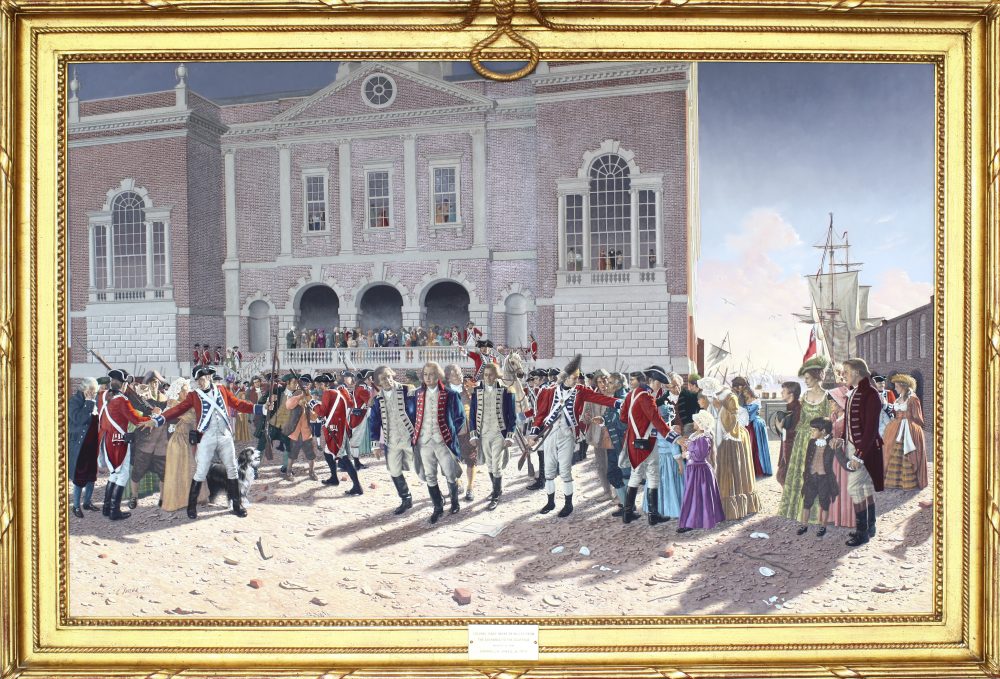
“The Execution of Isaac Hayne” by Caroll N. Jones, property of the South Carolina Historical Society.
On the morning of August 4, 1781, Colonel Isaac Hayne was led from the Exchange building through the streets of Charlestown to meet his fate at the gallows. He chose to walk instead of ride in the wagon with his coffin. The night before, the coffin was placed in the jail cell with him as a reminder of his impending execution. At the place of execution, according to witnesses, he placed the hood on his own head and signaled he was ready. Hayne’s execution was met with controversy and anger from the American forces who vowed revenge against the British.
Born on September 23, 1745, in Colleton County, Isaac Hayne was the only son of Isaac Hayne and his third wife Sarah Williamson. He inherited Hayne Hall Plantation, consisting of 23 enslaved people and 900 acres at Jacksonboro, from his father. Hayne and his partner William Hill owned the Aera Iron Furnace, which produced cannon and ammunition for Patriot forces during the Revolutionary War. At the time of his death, he owned Sycamore and Pear Hill Plantations along with lots in Beaufort and Charleston. He also owned 6,500 acres, mainly in the backcountry of South Carolina and at least 1,000 acres in Georgia. Hayne was described in a letter by John Rutledge to John Dickinson as “a planter, eminently domestic, a country gentleman, whose pride and pleasure it was to maintain that character par excellence.”
Hayne served in the Colleton County militia as a captain. In the latter part of 1775, he was stationed at Dorchester. In January of 1776, Colonel William Moultrie sent Captain Hayne’s detachment of 163 men to post at the northwest corner of Broad Street and Meeting Street in preparation for an attack by the British. By May of 1780 Charleston was occupied by British forces and Hayne was a senior captain of the Round O company, a mounted company from Colleton County stationed outside of the city. When American forces inside Charleston surrendered, Hayne and his men presumed that the terms of surrender applied to them, so they disbanded and returned to their homes. This is where the events that led to Isaac Hayne’s execution began.
There are several accounts with differing reasons as to why and how Hayne returned to Charleston after the surrender of the city. What is known is that Sir Henry Clinton, the commander in chief of the British forces, issued a proclamation stating that “all our militia prisoners on parole, not taken by capitulation, or in confinement, at the surrendering of Lincoln, to become British subjects, or return instantly to the commandant of Charleston.” Colonel Robert Ballingall, commander of the Colleton County loyal militia, urged Hayne to comply with the proclamation. Isaac Hayne traveled back to Charleston in the midst of a personal crisis. His family was stricken with smallpox. His eighteen-month-old daughter had died, and his wife and other children were deathly ill. His main interest in traveling to Charleston was to procure medicine and find a physician to attend his family. Upon his arrival, Hayne reported to the commandant Brig. General James Patterson who refused to allow him to return to his family unless he swore allegiance to the crown and became a loyal British subject. If he did not swear allegiance he would be imprisoned. Hayne, desperate to return to his family, declared allegiance to King George III. He expressly objected to the agreement to take up arms against his fellow Americans but swore allegiance nonetheless and returned to his family.
Hayne tried to remain neutral in the fight and kept his sworn word for nearly a year. Sometime in June 1781, Hayne gave in to repeated requests from the Patriot militia to return to service and was given a commission as a colonel. His return to the Patriot cayse encouraged some 200 men to follow him and boosted numbers in the militia. Hayne was captured on July 8, 1781, in a surprise attack by the British on his camp. He was immediately taken to Charleston and imprisoned in the jail at the Royal Exchange and Customs House. On July 26, 1781, Hayne received notice from Town Major Charles Fraser stating that he would face a Court of Enquiry. But, instead of a trial, the Commandant and Lord Rawdon notified him that he would be executed on July 31, 1781. Hayne asked for time for his children to arrive so that he could see say goodbye to them. The Commandant and Rawdon considered the request and changed the date of execution to August 4, 1781. Despite petitions for leniency by Lt. Governor William Bull II and pleas from others for his pardon, Isaac Hayne was executed on August 4, 1781. He was hanged by the British without a proper trial. His execution was met with ire by the Patriots, who saw their ranks increase, and essentially made him a martyr for the American cause in the Revolutionary War.